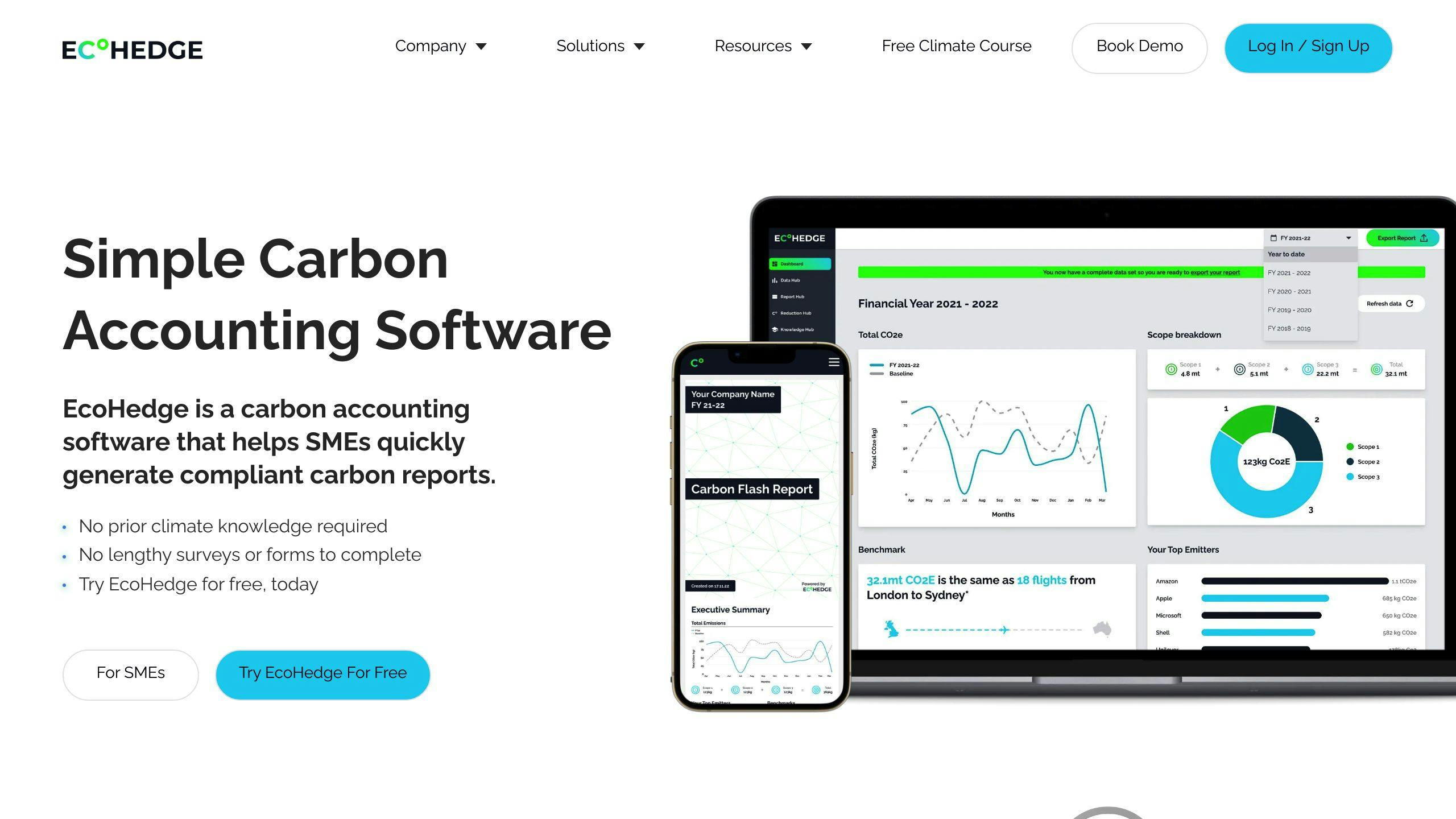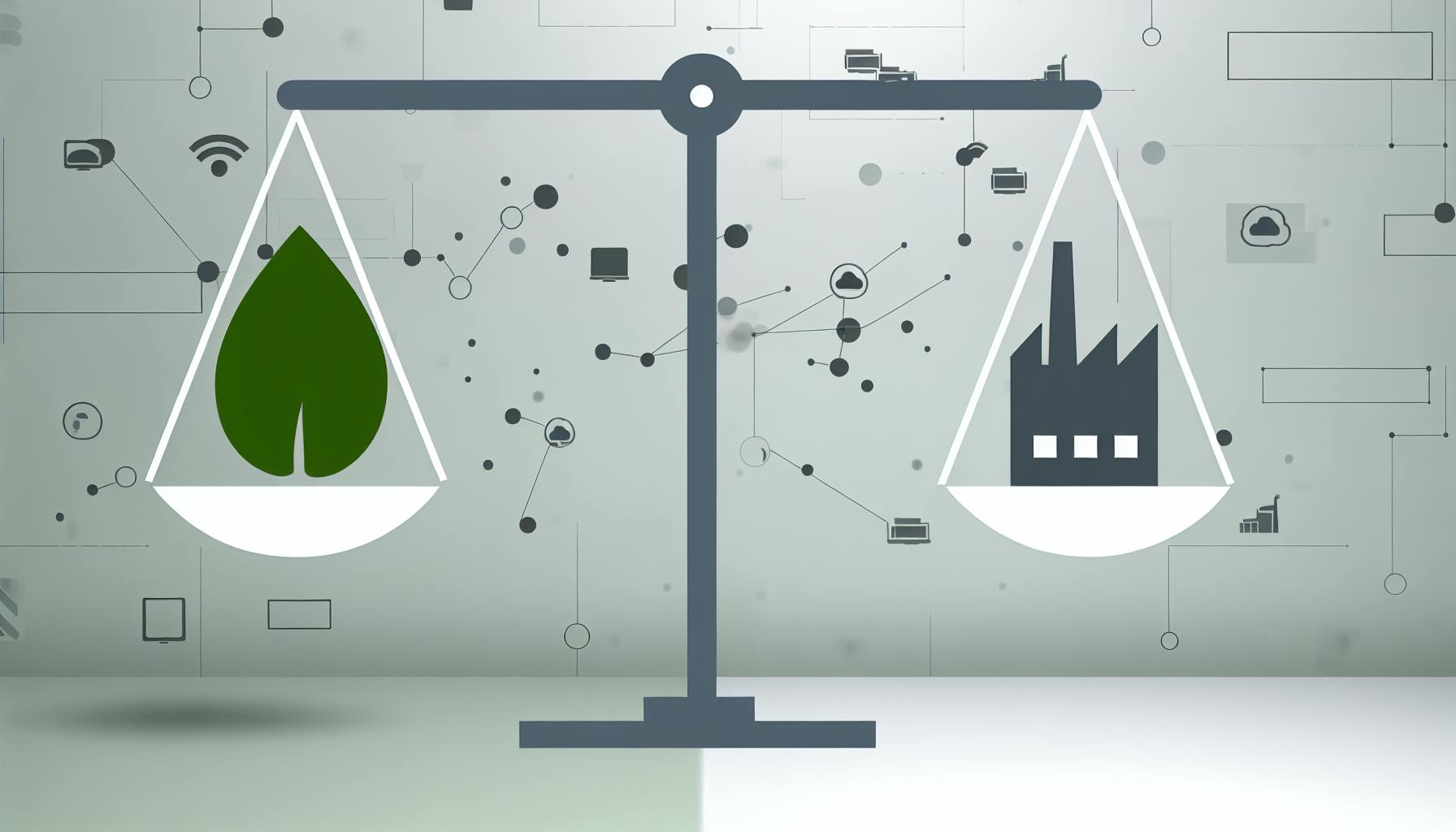Understanding your carbon footprint is key to helping the planet. It's about the total amount of greenhouse gases, including carbon dioxide, methane, and others, that our actions produce. Here’s a quick guide to get you started:
- What Is a Carbon Footprint?: A measure of the greenhouse gases we emit through our activities.
- Global Carbon Footprint Data: Shows the differences in emissions around the world.
- Calculating Your Carbon Footprint: Involves keeping track of direct and indirect emissions from your activities or business.
- Strategies for Reducing Your Footprint: Focuses on using less energy, choosing clean technology, and considering carbon offsetting.
- Tools and Resources: Websites and tools like EcoHedge and the EPA's Emission Factors Hub can help manage and reduce your carbon footprint.
Whether you're a small business or an individual, understanding and reducing your carbon footprint can make a significant difference in fighting global warming. It starts with recognising the sources of emissions and then taking steps towards more sustainable practices, from energy efficiency to clean technology adoption and beyond.
What Is a Carbon Footprint?
Think of a carbon footprint as a way to measure all the gases that warm up our planet, which come from things people, businesses, or events do. It's like counting how much bad air (CO2 and other gases) comes from making stuff, using stuff, or moving stuff around. For businesses, figuring out their carbon footprint means looking at everything from how they make and deliver products, to how employees get to work, and even what happens to their products when they're thrown away. This helps them see how they're affecting the climate.
The main gases we worry about are:
- Carbon dioxide (CO2)
- Methane
- Nitrous oxide
- Fluorinated gases
These gases keep heat close to the Earth, making it warmer over time. By keeping track of these emissions, we can find out which activities are the biggest problem and work on fixing them.
Global Carbon Footprint Data
According to Our World in Data, on average, each person on Earth is responsible for about 5 tons of CO2 a year. But, it's not the same everywhere:
- United States: 16.2 tons per person
- Canada: 15.6 tons per person
- China: 8.4 tons per person
- India: 1.9 tons per person
- Many African countries: less than 1 ton per person
This shows that richer countries put a lot more bad air into the atmosphere, so it's really important for them to take action. For small and medium businesses (SMEs), this means doing things like using less energy, getting better at what they do without wasting resources, choosing renewable energy, and balancing out their emissions. Keeping track of how they're doing over time helps them make sure they're doing their part to fight climate change.
Calculating Your Carbon Footprint
Carbon Accounting Basics
Carbon accounting is just a fancy way of saying we're keeping track of all the bad air (greenhouse gases) a business sends into the sky. This helps us see how much a company is affecting the environment.
There are three main types of emissions we look at:
- Scope 1: These are the direct emissions from stuff the company owns or controls, like their cars or the fuel they burn.
- Scope 2: These are indirect emissions from the electricity the company buys and uses.
- Scope 3: These are all the other indirect emissions related to the company's activities, like when employees travel for work or how they deal with waste.
To really understand your business's impact, you should measure at least the first two types. The third type can be trickier but gives you the full picture.
6 Steps to Calculate Your Business's Footprint
Here's how to figure out your company's carbon footprint in six steps:
- Determine boundaries - Decide what parts of your business to include. Start with the direct stuff (scope 1 and 2).
- Collect data - Gather info on how much energy, fuel, and other stuff you've used over a year. Don't forget to include shared things like office lights.
- Calculate emissions - Turn that data into tons of CO2e (that's carbon dioxide and other gases combined) using special factors. There are online tools that can help with this.
- Identify reductions - Look at your results to find where you can cut down on emissions, like using less energy.
- Set targets - Based on what you find, set goals for reducing emissions each year.
- Communicate progress - Tell people about your carbon footprint, your goals, and how you're doing. It shows you care about the environment.
By following these steps, you'll get a clear picture of how much bad air your business is responsible for and how you can do better. Keeping track and making updates helps you see your progress over time.
Strategies for Reducing Your Footprint
Efficiency First
Start by making your business use less energy. This could mean switching to energy-saving light bulbs, making sure buildings are well insulated, and getting rid of old, power-hungry appliances. An energy check-up can show you the best ways to save energy.
Spending money on making things more efficient usually pays off quickly. Plus, if you use less energy, there's more clean energy to go around for everyone. The biggest and most cost-effective step to reduce your carbon footprint is simply using less energy.
Clean Technology
Using clean, renewable energy is a big step for businesses to really cut down on emissions. This could mean putting solar panels on your roof or choosing to buy your electricity from renewable sources. This can greatly reduce the amount of bad air your business is responsible for.
The cost of clean technology has gone down a lot, making it easier and cheaper to switch. Solar and wind energy are now often the cheapest options. As these technologies get better and more renewable energy is used, switching becomes even easier.
Governments sometimes offer money to help with the cost of moving to renewable energy. This support is growing as taking care of our planet becomes more important globally. Using these government offers can make switching to clean energy faster for businesses.
Carbon Offsetting Considerations
Carbon offsetting means paying for projects that reduce emissions somewhere else to make up for the emissions your business causes. It's better than doing nothing, but not all offset projects are the same.
Simple tree planting doesn't help much and can be risky because of things like fires or logging. Better projects include protecting forests, providing clean cooking options, or supporting renewable energy in places that need it.
Making sure these projects really reduce emissions can be hard. And sometimes, these projects can cause problems, like hurting local communities or the environment.
Businesses should try to reduce their own emissions as much as possible before thinking about offsets. Offsets can be part of the solution for the emissions you can't avoid, but focusing on making your business more efficient and using renewable energy is a better way to make a big difference.
sbb-itb-0f1f828
Tools and Resources
This part talks about different tools and websites that can help businesses understand and lower their carbon footprint.
EcoHedge

EcoHedge is a tool that helps businesses keep track of how much carbon they're putting out. It's good for looking at all the different ways a company can affect the environment.
Some key features include:
- Figure out emissions from all activities
- See where most emissions come from
- Make goals based on science
- Keep track of improvements
- Create reports easily
EcoHedge makes it easier for companies to handle their carbon data and find ways to do better.
Other Helpful Tools
Besides EcoHedge, there are other tools and websites that can help with understanding your carbon footprint:
- EPA Emission Factors Hub - A place to find out how much carbon different activities produce, based on where you are and what industry you're in.
- Carbon Footprint Calculator - A simple way to guess how much carbon you or your home is responsible for.
- CERO Carbon Platform - A tool for businesses to figure out their carbon footprint for all types of emissions.
Using these tools along with other resources like checking how much energy you use and finding out about clean energy options can help small and medium businesses (SMEs) make a real difference in their environmental impact.
Conclusion
Getting to know how much pollution your business causes is a key first step for small and medium businesses (SMEs) wanting to do better for the planet. By figuring out how much bad air (greenhouse gases) your business activities make and aiming to make less of it, companies can really help in the fight against global warming.
This guide was all about making the tricky stuff easy to get, especially for SMEs. It showed you the basics of keeping track of your pollution, how to collect the right info, and how to turn that into a number that tells you how much you're contributing to global warming. Even with a small team and not a lot of resources, you can start to understand your business’s impact.
Once you know where you stand, you can start to make changes like using less energy, picking renewable energy, cutting down on travel, and buying smarter. While paying for projects to make up for your pollution (offsets) can help a bit, it's better to focus on actually polluting less. Keeping an eye on your progress also shows everyone how you're doing over time.
We talked about some handy online tools like EcoHedge and the EPA's Emission Factors Hub that can make figuring this stuff out a bit easier. Some businesses might need extra help with crunching the numbers or figuring out how to pollute less, and that’s okay too.
In short, every business has a part to play in stopping the planet from getting too hot, and it doesn’t have to be complicated. Small steps taken together can make a big difference. SMEs have a great chance to show how it's done, with the right info and tools.
Related Questions
What is a carbon footprint for beginners?
Imagine your carbon footprint as the total amount of pollution your activities add to the air. For a business, this means looking at the pollution from running the place, using vehicles, using electricity, dealing with waste, and everything involved in making and selling products and services. If you're just starting to learn about this, focus on the most obvious sources of pollution like your buildings, vehicles, and the energy you buy. There are free online tools that can help you figure out your carbon footprint using this information. Lowering your business's carbon footprint helps in the big fight against climate change.
What is the best definition of carbon footprint?
The clearest way to define a carbon footprint is by looking at all the pollution created directly and indirectly by a person, business, event, or product. This is measured in the amount of carbon dioxide equivalent (CO2e), considering all six main greenhouse gases. It includes pollution from using energy in buildings, making things, driving company cars, business trips, throwing away waste, and so on. Understanding our carbon footprint helps us see how we contribute to global warming and take responsibility for our part in it.
How do you explain carbon footprint to a child?
Here's a simple way to explain it to a child: Think of your carbon footprint as counting all the ways you make air dirty, which helps make the Earth warmer. When you ride in a car or bus, it makes dirty air. The electricity for your lights and gadgets comes from places that also make dirty air. The things you buy are made in factories that pollute the air too. All these things together make up your carbon footprint. If we all try to make less dirty air, we can help stop the Earth from getting too warm.
What are the 5 R's of carbon footprint?
The 5 R's are a simple guide to help lower your carbon footprint:
- Refuse - Say no to things you don't need like single-use plastics and buying too much.
- Reduce - Use less energy and fuel. Travel less by car and plane. Buy only what you really need.
- Reuse - Find new uses for things instead of throwing them away. Fix, share, and give things to others.
- Rot - Turn food scraps and yard waste into compost instead of throwing it away.
- Recycle - Make sure to recycle things like paper, glass, metals, and plastics the right way. Follow what your local area says.
Using the 5 R's in how your business works, how employees act, and in what you buy can really help make your organisation's carbon footprint smaller. It also shows others how they can do the same.



.png)


